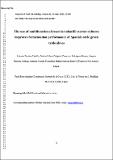Por favor, use este identificador para citar o enlazar a este item:
http://hdl.handle.net/10261/207281COMPARTIR / EXPORTAR:
 SHARE
BASE SHARE
BASE
|
|
| Visualizar otros formatos: MARC | Dublin Core | RDF | ORE | MODS | METS | DIDL | DATACITE | |

| Título: | The use of multifunctional yeast-lactobacilli starter cultures improves fermentation performance of Spanish-style green table olives |
Autor: | Benítez-Cabello, Antonio CSIC ORCID ; Calero-Delgado, Beatriz CSIC; Rodríguez-Gómez, Francisco J. CSIC ORCID; Bautista-Gallego, J. CSIC ORCID ; Garrido Fernández, A. CSIC ORCID ; Jiménez Díaz, Rufino CSIC ORCID ; Arroyo López, Francisco Noé CSIC ORCID | Palabras clave: | Autoinducer Biofilms Compositional analysis Multifunctional starters Metagenomic analysis Sensory analysis Table olives |
Fecha de publicación: | oct-2020 | Editor: | Elsevier | Citación: | Food Microbiology 91: 103497 (2020) | Resumen: | In this work, Lactobacillus pentosus LPG1, Lactobacillus pentosus Lp13, Lactobacillus plantarum Lpl15, and Wickerhanomyces anomalous Y12, all of them previously isolated from fermented table olive biofilms, were used (alone or in combination) as multifunctional starters for Manzanilla Spanish-style green table olive fermentations. Their performances were evaluated through the changes in the key physico-chemical and microbiological parameters, correlation between AI-2 production and biofilm formation, inoculum imposition, metataxonomic analysis and sensory characteristics of the finished products. Inoculation only with lactic acid bacteria (LAB) strains led to higher titratable acidities and lower pH values than the spontaneous fermentation (non-inoculated control), mainly during the first steps of processing. However, the sequential inoculation of the yeast and then the combination of the 3 LAB strains showed the most favourable evolution. LPG1 strain and, particularly Lp13, were excellent biofilms former and showed the major imposition on the fruit epidermis, as corroborated by rep-PCR analysis. Production of AI-2 was lower in the treatment inoculated exclusively with yeast Y12 but had the highest presence in the sequential yeast-LAB inoculum, with its maximum concentration and maximum LAB population on fruits (19th days) strongly related. Metataxonomic analysis of the biofilms at the end of the fermentation revealed, in addition to Lactobacillus, high proportions of sequences from genera Marinilactobacillus, Alkalibacterium, Halolactobacillus, and low levels of Halomonas and Aerococcus. Compositional data analysis of the omics data revealed that Lpl15 was scarcely efficient for controlling the spontaneous microbiota since its treatment presented the highest proportions of Aerococcus genus. Finally, the sensory analysis showed similar characteristics for the treatment inoculated with LPG1 and the spontaneous process, with olives inoculated with the yeast (alone or in combination with Lactobacillus strains) showing attractive scores. Then, inoculation of Spanish-style table olive fermentations with a sequential yeast and LAB combination could be an advisable practice. | Descripción: | 8 Figuras.-- 3 Tablas | Versión del editor: | http://dx.doi.org/10.1016/j.fm.2020.103497 | URI: | http://hdl.handle.net/10261/207281 | ISSN: | 0740-0020 | E-ISSN: | 1095-9998 |
| Aparece en las colecciones: | (IG) Artículos |
Ficheros en este ítem:
| Fichero | Descripción | Tamaño | Formato | |
|---|---|---|---|---|
| PostP_2020_FM_V91_103497.pdf | 634,8 kB | Adobe PDF |  Visualizar/Abrir |
CORE Recommender
Page view(s)
143
checked on 23-abr-2024
Download(s)
210
checked on 23-abr-2024
Google ScholarTM
Check
NOTA: Los ítems de Digital.CSIC están protegidos por copyright, con todos los derechos reservados, a menos que se indique lo contrario.
